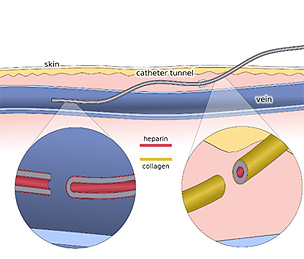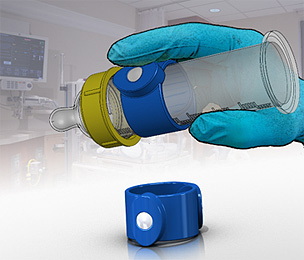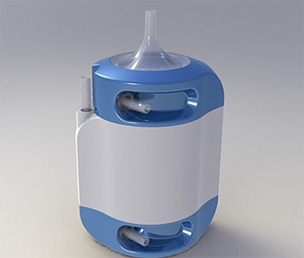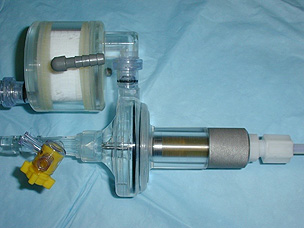Pediatric Oncology CatheterPediatric oncology care commonly requires the use of small gauge central venous catheters which are associated with high risk of bloodstream infections. Central line-associated bloodstream infections result in increased morbidity, prolonged hospital stay, and substantial health care costs. Ension has engineered catheter surfaces which both prevents biofilm formation at vascular-contacting surfaces and promotes skin and tissue healing at percutaneous surfaces.
Pediatric Hemodialysis CatheterThe most common hemodialysis catheter complications are thrombosis, inflammation, and biofilm formation directed by the body’s non-specific immune response to foreign material exposure. The adsorption of circulating proteins onto the catheter’s surface directs conformational changes that activates inflammatory cells. Ension has engineered a surface which mimics the naturally occurring endothelial glycocalyx for application on hemodialysis catheter substrates to minimize the thrombogenic and inflammatory potential.
Breast Milk Thickening for Pediatric DysphagiaPatients with swallowing dysfunction (dysphagia) require thickened fluids to mitigate aspiration risk. For young patients, breast milk thickening is complicated as some thickeners (cereal and starches) are quickly broken down by a-amylase in the milk, while other gum-based thickeners (xanthan, guar, carob bean) are potentially harmful to the young developing gut and have been linked to life threatening bowel complications. Ension is developing a system to inhibit a-amylase activity in breast milk to facilitate safe thickening with cereal and starch-based ingredients.
System for Objective Jaw AssessmentJaw function assessments are critical to the diagnosis of deficiencies, tracking of patient progress and identification of optimal therapies in the treatment of oral motor deficiencies. Currently available jaw assessment programs rely on subjective manual observations of patient jaw function and have limited practical use for objective data collection. Ension is developing a system that provides quantitative objective assessment of jaw function in pediatric patients. The system facilitates trackable patient rehabilitation metrics and comparison of therapy outcomes independent of user or institutional subjectivity providing evidence- based guidance of therapy practices.
Pediatric Extracorporeal Life Support System SimulatorThe effective, safe, and efficient delivery of pediatric critical care requires learning and proficiency of the necessary skills and communication for all team members. This need is heightened when the use of life support technology, such as extracorporeal membrane oxygenation (ECMO) or ventricular assist devices (VAD), is added to the treatment plan. Accurate and realistic simulation of clinical scenarios can maximize the performance of the team, minimize threats to patient safety, and improve patient outcomes.
Tools for Oral Feeding Transition and Sensory IntegrationPediatric patients who are born prematurely or with sensory processing deficiencies can benefit from therapeutic sensory input to facilitate desensitization or engagement with occupation activities. Ension is developing a versatile sensory input tool designed to fit a variety of common occupational objects. Gentle vibration is transmitted from the tool through tethered objects to provides parents, caregivers and therapists with a versatile tool to deliver soothing massage and sensory integration to young infants.
Fetal PerfusionDue to advances in fetal echocardiography, fetal cardiac surgery is an increasingly viable strategy to prevent simple cardiac lesions from progressing into serious defects requiring multiple corrective surgeries after birth. Ension has developed a novel fetal cardiac bypass circuit designed to minimize placental dysfunction by minimizing priming volume, delivering pulsatile flow, and providing adequate gas exchange when the placenta is excluded from the fetal circulation. The modular, compact system is based on either an occlusive or custom rotary pump and high efficiency oxygenator. The compactness of the design allows the pump-oxygenator to be position with the surgical field. Proprietary surface treatments and other features of the system enables advancement in utero surgery by allowing clinicians to more safely perform fetal cardiac surgery by avoiding placental dysfunction and, as a result, reduce if not eliminate the multiple complicated post-birth surgical corrections currently required. The fetal system configuration can be easily scaled to allow highly portable support in larger neonate and pediatric patient populations.
|
Pediatric oncology catheter with region-specific bioactive surfaces: immobilized heparin (red) on blood and fluid contacting surfaces and conformal collagen matrix (yellow) on tissue contacting surfaces.
A conceptual illustration of NutriCue, a system to provide oral stimulation to promote infant engagement during transitional bottle feeding.
Ension’s pediatric pump-oxygenator
|





